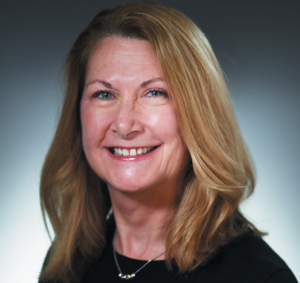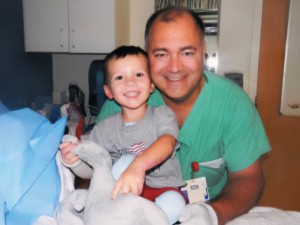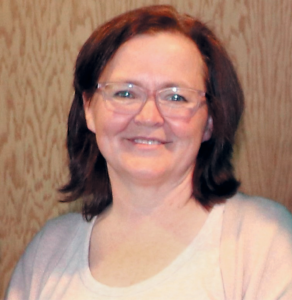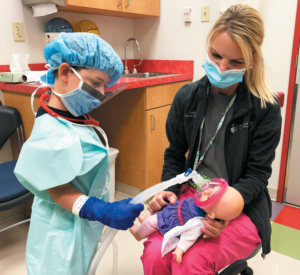
ARLENE BURNS, BSN, RN, CPN
Arlene Burns, BSN, RN, CPN, starts her day like many others over the past 38 years. She walks into Shriners Children’s Ohio and heads straight to the PACU — the postanesthesia care unit — where she works as a nurse caring for young patients recovering from surgery. Arlene checks the schedule to see which patients she will meet for the first time and which are children she’s known for years as they return to the hospital for care.
“We’re the first faces children see after surgery,” she explained. “It can be scary, so we make sure they know they’re safe and comfortable. It’s especially reassuring when I already know the family. They trust me to take care of them, and seeing a familiar face helps ease their anxiety.”
Arlene joined the Shriners Children’s Ohio team in 1986 as an ICU nurse and transport team member. Arlene logged more than 200 flights to bring children with critical burns to Shriners Children’s.
“When I would first meet the families, I could see they were afraid,” she said. “But I would tell them, ‘There is a light at the end of this tunnel. Shriners Children’s will guide you. We will get you there.’”
Decades later, Arlene said that although her nursing roles have changed over the years, her dedication to the mission has remained the same. “It’s all about our compassionate, wrap-around care,” she said. “We have an entire team that rallies around our patients and families and works together for the best outcome possible.”
Unique nursing culture
Arlene is just one of about 650 nurses across the Shriners Children’s healthcare system. Their roles range from direct care nurses and nurse practitioners to clinical educators, infection control specialists, care managers and nurse leaders. Each nurse contributes uniquely to the organization’s mission.
Nursing is not just a job — it’s a calling. At Shriners Children’s, that means being part of a team devoted to providing the best care to children. According to a workplace survey last year, 36% of Shriners Children’s nurses have been in their roles, taking care of patients, for over 10 years. But many stay with the organization for decades.
What makes them stay?
“Shriners Children’s is somewhat unique in that patients are cared for over a long time and bonds are formed,” said Chief Nursing Officer Beverly Bokovitz, DNP, RN, NEA-BC, FAAN. “The commitment to our mission builds an inherent trust between nurse and child that you don’t often see elsewhere. It’s those stories about the connections between patients and nurses that make us special.”
Healing connections
Take Shriners Children’s Boston patient Ben and nurse Richard Sederman, RN, CPN.

Over the years, Ben’s family developed a close connection with their nurse, Rich.
Rich has been a nurse on the inpatient unit for more than a decade. His ready smile and catalog of child-friendly jokes routinely put patients at ease. Rich has forged special bonds with many families, who find comfort in his approach to patient care.
Ben, 13, has been treated for burn injuries at Shriners Children’s Boston since he was a toddler. Over the years, his family developed a close connection with Rich, Ben’s mom Jessica explained. “In very challenging times, Rich made us smile and gave us hope that the accident would one day be a distant memory.”
Ben is a talented thespian who has played the lead in several school and community plays. Rich and his family catch Ben in a theater production every chance they get.
“Ben’s bravery and determination have a permanent place in my heart,” Rich said. “I remember how tough he was during painful treatments. I owe him and his parents for a whole bunch of smiles and for making me a better nurse.”
Redefining nursing education
Patient relationships may be central to Shriners Children’s unique nursing culture, but that doesn’t tell the whole story. The organization’s emphasis on clinical education also sets Shriners Children’s apart. It ensures that nurses are supported, mentored and prepared for the ever-evolving challenges of today’s healthcare trends.
“Shriners Children’s is redefining nursing education through initiatives that train and support our nurses and position them to provide the best, most innovative care based on the latest evidence,” said corporate nurse scientist Marni Kellogg, Ph.D., RN, CPN, CNE.
“As a parent, I would be excited to understand what this means to the care of my child, and I would also be happy knowing Shriners Children’s is making such an investment in their nurses.”
Shriners Children’s nursing strategic priorities are designed to empower nurses and foster collaboration between clinical nurses and leadership to meet patient care demands.
Mentorship drives excellence
One way Shriners Children’s attracts and retains top nursing talent in this competitive healthcare landscape is through a robust program that pairs new nurses with experienced mentors, ensuring a smooth transition to our unique care environment.

TAMMY NOBLE, MSN, RN, CPN, CBRN
Tammy Noble, MSN, RN, CPN, CBRN, created the training course for preceptors (experienced nurses) who serve as teachers and mentors to new nurses. The preceptor course curriculum incorporates a technique called action mapping, teaching employees the actions they need to take to succeed. Piloted at Shriners Children’s Boston, Tammy’s project stemmed from her desire to contribute meaningfully to the nursing profession and the Shriners Children’s mission. Tammy presented the preceptor course at the Shriners Children’s Clinical Education Summit in Tampa in September 2023. In 2024, it was adopted as a systemwide best practice, and more than 150 staff members have now accessed it.
“Even though we are in different locations, we share the same challenges,” Tammy said. “To be able to work together and identify strategies for success has been the best part of this experience.”
Megan Klevorn, BSN, RN, a nursing professional development generalist at Shriners Children’s St. Louis, attended the preceptor course, which she described as perfectly timed. The course provided valuable insight and skills as she prepared to shift from her role as a nurse in the pediatric acute care unit to becoming a nursing professional development practitioner on the systemwide clinical education team.
While working with the team at the summit, Megan participated in team-building activities. She contributed to the development of an evidence-based nursing orientation program, which is set to launch systemwide this year. The team also tested a new simulation training program, discussed the scope and responsibilities of the nursing professional development practitioner role, and reviewed systemwide clinical education programs and how they align with the mission and vision of Shriners Children’s.
Supporting nurse leaders
Supporting nursing leadership is another priority at Shriners Children’s.
“My job as chief nursing officer is to make sure we hire the very best nurses and nurse leaders, and that they have the tools, training and mentorship they need to thrive,” said Bokovitz. This ensures that leaders can support their teams effectively, creating a ripple effect of excellence across the organization and leading to excellent patient care.
One such leader is Kandace Stratton, BSN, RN, CPAN. Although she is one year into her role as nurse manager of surgical services at Shriners Children’s Lexington, she started her journey as a patient when she was a preteen.
When Kandace was 11, she came to Shriners Children’s for scoliosis care. For two years, Kandace wore a brace and, at 14, had surgery to permanently correct the curve in her spine.
Just five years after recovering from spinal fusion surgery, Kandace came to work at Shriners Children’s Lexington. She began as a certified nursing assistant (CNA) and then worked as an RN, helping children recover from their surgeries.
“Working at Shriners Children’s feels like a full-circle moment for me,” she said. “I hated that I had scoliosis as a kid, but there’s a different feeling here. It’s not like any other place. The staff became like family to me and made a scary time more comfortable for me and my parents.”
As a manager, Kandace plays a key role in providing that same compassionate, wrap-around care for patients and their families.
A vision for the future

Shriners Children’s strives to empower nurses to thrive with world-class tools, training and mentorship.
“We are changing the future of care at Shriners Children’s,” said Bokovitz. “Initiatives such as our nursing research and evidence-based practice program (see next page) and the preceptor program, as well as the nurse residency and orientation initiatives in development, advance the nursing profession.”
The heart of Shriners Children’s lies in its people, and nurses are at the core of that mission. They’re not just caregivers — they’re educators, leaders, mentors and lifelong advocates for the children they serve. Kellogg said, “We are creating a culture where nurses want to work here — and they stay — because they are supported with best practices and have a voice in the care of their patients.”
National Nurses Week, May 6-12, 2025
National Nurses Week was established in the United States in 1994 to honor the contributions nurses make to healing others and making this world a kinder, better place. Every year, Nurses Week takes place from May 6 to May 12, an ending date chosen quite consciously. May 12 is the birthdate of Florence Nightingale, who is credited as the founder of modern nursing.
We recognize and honor all the compassionate and dedicated Shriners Children’s nurses who make an impact for their patients every day.





